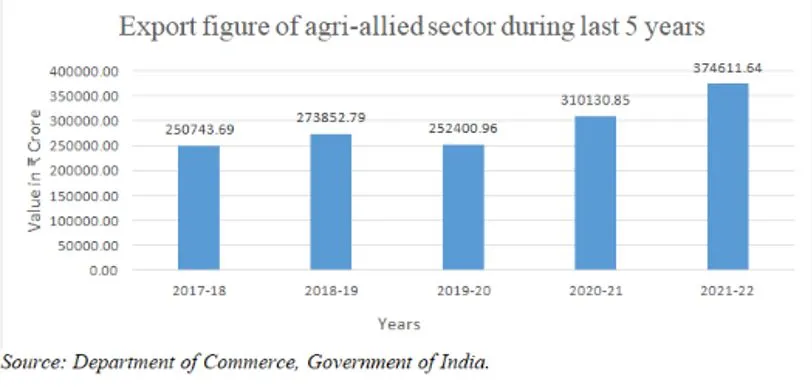

14th November 2024 (10 Topics)
Context
India has emerged as one of the world's largest agricultural exporters, with exports valued at USD 53.1 billion in 2022-2023, a remarkable six-fold increase from USD 8.7 billion in 2004-2005.
However, as agricultural exports grow rapidly, there persists multiple challenges to the ‘sustainability’.
What is the status of India’s agricultural export?
- India is one of the world’s largest agricultural product exporters. The Indian agricultural export is valued at USD 53.1 billionin 2022-2023, up from USD 8.7 billion in 2004-2005, a six-fold increase in less than two decades.
- Why it matters (Significance): For an economically developing economy like India, exports play a significant role in strengthening the economy by increasing revenue, foreign exchange, and transactional options.
- Challenges/Concerns: The rapid surge in exports poses multiple challenges to the sustainability of the production, processing, and distribution systems of the respective commodities. This involves addressing ecological, economic, and social factors to promote long-term sustainability in agriculture, especially for commodities like tea, sugar, and millets.
What is Sustainability in Agriculture?
- A truly sustainable agricultural commodity is not just economically viable but also ecologically and socially responsible. It must be built on three pillars:
- Ecological Sustainability: Ensuring the conservation of natural resources, preventing land degradation, and promoting biodiversity.
- Economic Sustainability: Ensuring that the agricultural system is profitable and supports livelihoods without over-exploiting resources.
- Social Sustainability: Promoting fair labor practices, workers’ rights, and social equity in the agricultural sector.
- All of these need strong governance and policies to ensure long-term viability.
- Sustainability should not only focus on agricultural production but should also encompass the entire lifecycle, including pre-sowing, production, and post-harvest stages.
- For example, sustainability challenges in tea and sugar highlight the need for more comprehensive approaches that address environmental and social issues across all stages of production and trade.
Case Studies: Sustainability Challenges in Key Commodities
- Tea
- Export and Production: India is the world’s fourth-largest tea exporter and second-largest producer, with tea exports valued at over USD 793 million in 2022-2023. However, there are significant sustainability challenges within the tea industry:
- Human-Wildlife Conflicts: Around 70% of tea plantations are located near forests, which are migration routes for elephants. These interactions can lead to crop damage and conflicts.
- Chemical Use: Pesticides constitute up to 85% of pesticide use in tea plantations, resulting in chemical residues that pose health risks like cancer and neurotoxicity.
- Labor Issues: Many tea plantation workers, especially women, face underpayment and unsafe working conditions, with poor enforcement of labor laws. These issues highlight the need for better management practices, stricter pesticide regulations, and improved labor conditions.
- Sugar
- Water Usage and Environmental Impact: India is the second-largest sugar producer globally, with sugar exports growing by 291% between 2013-2014 and 2021-2022. However, sugar production has severe environmental consequences:
- Water Depletion: Sugarcane requires vast amounts of water, with 1 kg of sugar requiring between 1,500-2,000 liters of water. This contributes to the over-extraction of groundwater, particularly in states like Maharashtra and Karnataka, leading to water shortages for other crops.
- Biodiversity Loss: Natural ecosystems like grasslands and savannahs have been converted into sugarcane fields, leading to biodiversity loss and increased pressure on water resources.
- Labor Issues: The sugar industry also faces labor challenges, with workers in harsh conditions and exposed to extreme heat, particularly in the context of rising temperatures.
- Millets:
- Ecological and Social Benefits: Millets present a more sustainable option for both domestic consumption and export. Millets are resilient to drought conditions, require fewer inputs, and improve soil health. Their rise in popularity is demonstrated by a significant increase in exports from USD 26.97 million in 2020-2021 to $75.45 million in 2022-2023.
- Environmental Impact: Millets use fewer water resources compared to sugarcane or rice and help preserve soil quality, making them an environmentally friendly crop.
- Social Impact: Millets also provide nutritional security, especially for rural communities, and are less resource-intensive, contributing to a more resilient agricultural system.
Government Initiatives to promote agriculture export
|
More Articles


